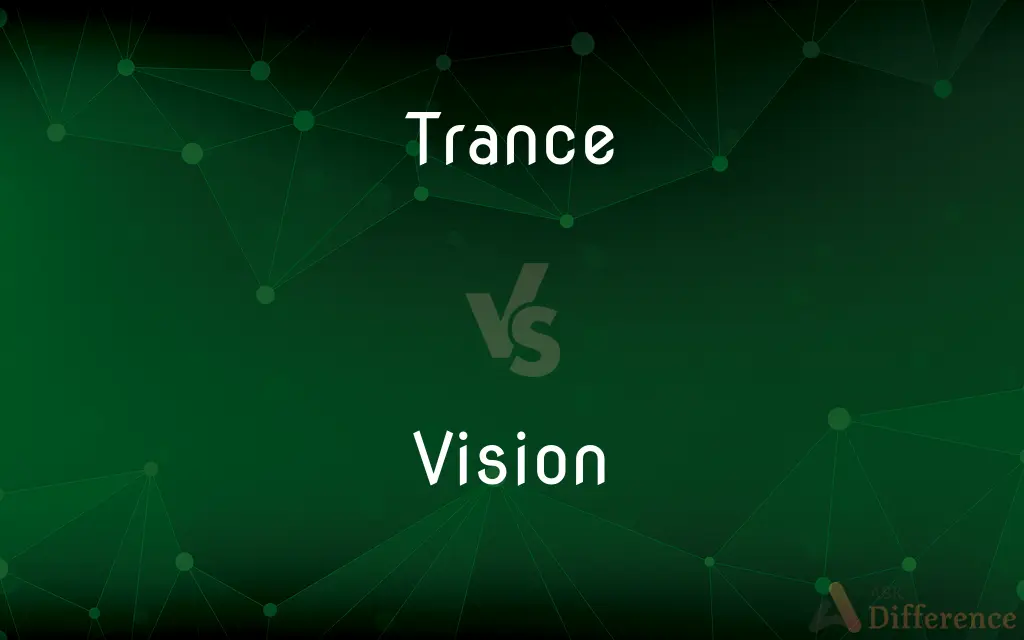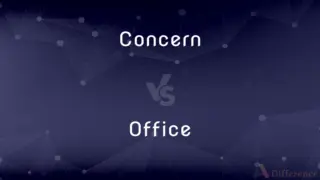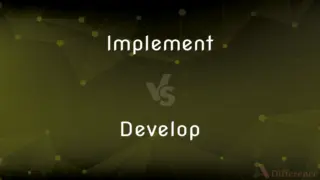Trance vs. Vision — What's the Difference?
Edited by Tayyaba Rehman — By Fiza Rafique — Updated on February 26, 2024
Trance involves a state of deep focus or unconsciousness, often detached from immediate surroundings, whereas a vision is a vivid mental image of the future or a supernatural apparition.

Difference Between Trance and Vision
Table of Contents
ADVERTISEMENT
Key Differences
A trance is characterized by a deep state of relaxation or hypnosis, where an individual may lose awareness of their surroundings and enter a state of altered consciousness. This can be induced through meditation, music, or hypnotherapy. Visions, on the other hand, are experienced as clear, often profound mental images or appearances that seem real, relating to the future, spiritual insights, or supernatural occurrences. They are not induced but spontaneously occur, often imbued with significant personal or cultural meaning.
Trances are often sought intentionally for various purposes, including spiritual, therapeutic, or relaxation reasons, while visions are typically unexpected and can have a profound impact on the individual’s life or beliefs. Trances can be controlled and emerged from deliberately, whereas visions are spontaneous and their timing and content are not controlled by the individual.
In trances, the focus is inward and can involve a disconnection from physical senses, facilitating deep relaxation or therapeutic introspection. Visions, however, although they may also involve an inward focus, are distinguished by their perceived external origin or significance, often conveying messages, warnings, or revelations.
The state of trance is generally considered a psychological or physiological state that can be explained within the frameworks of neuroscience and psychology. Visions, however, often cross into the realms of spirituality, religion, and the paranormal, challenging empirical explanation and interpretation.
Both trances and visions represent different aspects of human consciousness and perception. While a trance is a state one might enter into, a vision is an experience that comes to one, each offering unique insights or alterations in perception.
ADVERTISEMENT
Comparison Chart
Nature
A state of deep focus or unconsciousness.
A vivid mental image or supernatural apparition.
Inducement
Often intentionally induced.
Spontaneously occurs without intention.
Purpose
Relaxation, therapy, spiritual practices.
Insight, prophecy, spiritual or cultural significance.
Control
Can be entered and exited at will.
Not controlled by the individual; happens spontaneously.
Interpretation
Psychological, related to altered states of consciousness.
Often spiritual or supernatural, open to interpretation.
Compare with Definitions
Trance
A state of deep concentration or unconsciousness detached from surroundings.
The hypnotist induced a trance in his patient for therapeutic purposes.
Vision
A vivid mental image of the future or a supernatural apparition.
The prophet claimed to have had a vision of the world’s end.
Trance
Often used in meditation to reach deeper levels of consciousness.
She entered a trance during her meditation practice to explore her inner thoughts.
Vision
Can occur in dreams or during moments of intense focus.
While meditating, he experienced a vision that guided his decisions.
Trance
Can be facilitated by repetitive music or rhythms.
The drum circle's rhythm brought him into a trance.
Vision
Often carries significant personal, spiritual, or cultural meaning.
Her vision of a peaceful future inspired her community.
Trance
Utilized in therapy to access suppressed memories.
Hypnotherapy sessions often involve bringing the patient into a trance.
Vision
Not limited by current reality or practical constraints.
The inventor’s vision for a flying car was ahead of its time.
Trance
Characterized by reduced awareness of the external environment.
Lost in a trance, he was oblivious to the world around him.
Vision
Sometimes considered a mystical or religious experience.
Saints and mystics throughout history have reported visions of divine figures.
Trance
Detachment from one's physical surroundings, as in contemplation or daydreaming.
Vision
Something that is or has been seen.
Trance
Trance is a state of semi-consciousness in which a person is not self-aware and is either altogether unresponsive to external stimuli (but nevertheless capable of pursuing and realizing an aim) or is selectively responsive in following the directions of the person (if any) who has induced the trance. Trance states may occur involuntarily and unbidden.
Vision
Unusual competence in discernment or perception; intelligent foresight
A leader of vision.
Trance
A hypnotic, cataleptic, or ecstatic state.
Vision
The faculty of sight; eyesight
Poor vision.
Trance
A state in which the soul seems to have passed out of the body into another state of being, or to be rapt into visions; an ecstasy.
And he became very hungry, and would have eaten; but while they made ready, he fell into a trance.
My soul was ravished quite as in a trance.
Vision
A mental image produced by the imagination.
Trance
A psychological state induced by (or as if induced by) a magical incantation
Vision
To see in a vision.
Trance
A state of mind in which consciousness is fragile and voluntary action is poor or missing; a state resembling deep sleep
Vision
(countable) Something imaginary one thinks one sees.
He tried drinking from the pool of water, but realized it was only a vision.
Vision
Something unreal or imaginary; a creation of fancy.
Vision
The ability to see; the faculty of vision
Vision
The formation of a mental image of something that is not perceived as real and is not present to the senses;
Popular imagination created a world of demons
Imagination reveals what the world could be
Common Curiosities
How do you know if you've had a vision?
A vision is typically a vivid, impactful experience that feels significantly different from normal thoughts or dreams, often leaving a lasting impression.
Is being in a trance the same as sleeping?
No, a trance is a specific state of consciousness different from sleep, characterized by focused attention or altered awareness.
Can trances be dangerous?
Trances themselves are generally safe, especially under the guidance of a trained professional, but unsupervised practices in inappropriate settings can pose risks.
Are visions considered real?
The reality of visions is subjective and varies greatly depending on personal, cultural, and religious beliefs.
Can anyone have a vision?
While visions are more commonly reported by individuals with deep spiritual or religious beliefs, they can potentially occur to anyone.
Do visions have to be religious or spiritual?
While often associated with spiritual or religious contexts, visions can also encompass personal or secular insights and future aspirations.
Can trances improve health?
Yes, trances induced for therapeutic purposes, such as in hypnotherapy, can help with stress, anxiety, pain management, and various psychological issues.
What triggers a trance?
Trances can be triggered by meditation, music, rhythmic sounds, or hypnotic suggestion.
What is the difference between a dream and a vision?
Dreams occur during sleep and are part of the normal sleep cycle, while visions are considered to be more significant, vivid experiences that occur while awake or in a state of trance.
What is the significance of visions in history?
Visions have often played a crucial role in historical events, influencing leaders, shaping religious beliefs, and inspiring movements.
How long can a trance last?
The duration of a trance can vary from a few minutes to several hours, depending on the method of induction and the individual's response.
How are trances used in religious practices?
In many religions, trances are used as a means to deepen spiritual connection, communicate with the divine, or as part of ritualistic practices.
Can children experience trances or visions?
Yes, children can enter trance states, often through play or imagination, and may also report experiences that could be described as visions.
Is it possible to induce a vision?
Unlike trances, visions cannot be intentionally induced and occur spontaneously, often in contexts of significance to the individual.
Can technology induce a trance?
Yes, certain technologies, like binaural beats or VR, can be designed to induce trance states for relaxation, meditation, or therapeutic purposes.
Share Your Discovery

Previous Comparison
Concern vs. Office
Next Comparison
Implement vs. DevelopAuthor Spotlight
Written by
Fiza RafiqueFiza Rafique is a skilled content writer at AskDifference.com, where she meticulously refines and enhances written pieces. Drawing from her vast editorial expertise, Fiza ensures clarity, accuracy, and precision in every article. Passionate about language, she continually seeks to elevate the quality of content for readers worldwide.
Edited by
Tayyaba RehmanTayyaba Rehman is a distinguished writer, currently serving as a primary contributor to askdifference.com. As a researcher in semantics and etymology, Tayyaba's passion for the complexity of languages and their distinctions has found a perfect home on the platform. Tayyaba delves into the intricacies of language, distinguishing between commonly confused words and phrases, thereby providing clarity for readers worldwide.















































